|
JESUIT
INSTITUTIONS
IN
LITHUANIA
|
|
The
Jesuit Church and College, Kaunas
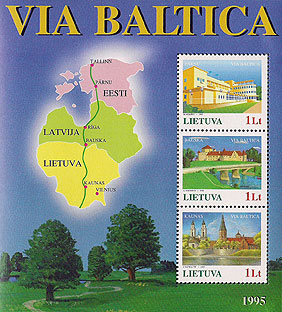
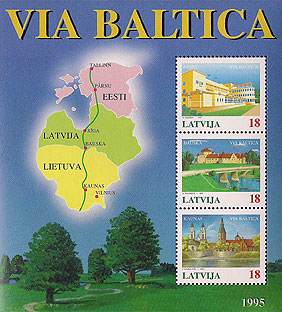
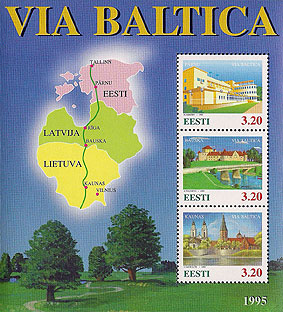
Via Baltica: a Joint Issue of Lithuania, Latvia and Estonia;
each country also issued a single stamp of its own feature
The bottom stamp of each (see enlargements below) shows the Jesuit Church
of St. Francis Xavier to the left.
LITHUANIA, 1995, Scott 508, LATVIA, 1995, Scott 395, ESTONIA, 1995, Scott 289
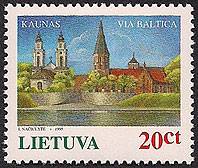
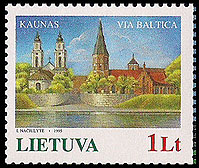
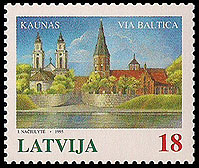
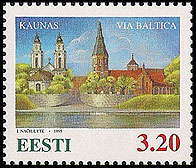
LITHUANIA, 1995, the single stamp, Scott 509 and the souvenir sheet stamp, Scott
509c
LATVIA, 1995 Scott 395c and ESTONIA, 1995, Scott 289c
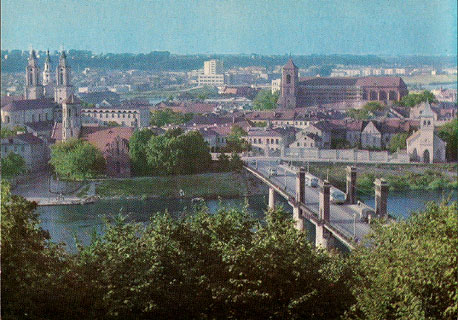
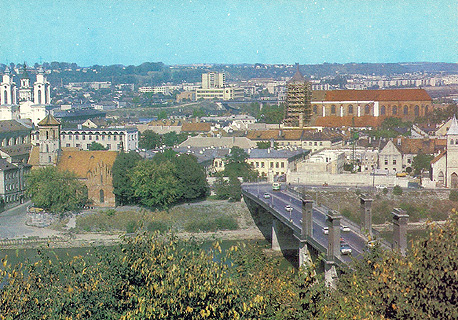

USSR, 19 August 1975, USSR, 16 October 1981, and USSR, 19 November 1987
postal cards showing slightly different views of the Jesuit Church of St.
Francis Xavier and adjacent school buildings
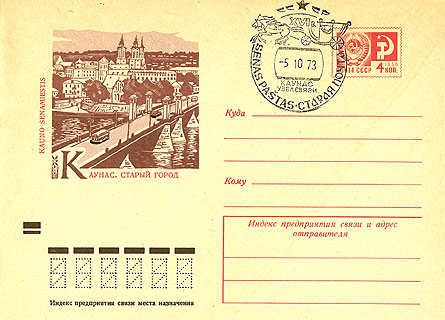
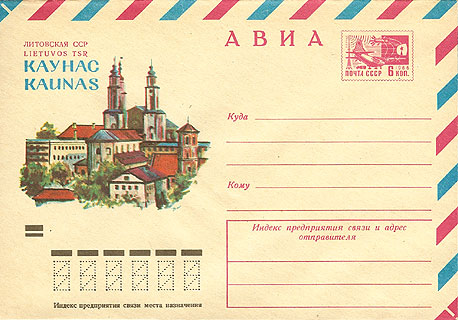
RUSSIA (USSR), 22 June 1973, regular and 13 November 1973 air postal envelopes
showing Jesuit Church of St. Francis Xavier and adjacent school buildings
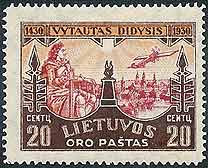

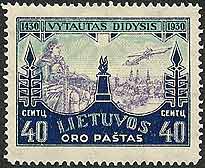
LITHUANIA, 1930, the church may be seen under the tail of the airplane,
Scott C43-C44
In 1642 Jesuits opened their first residence in Kaunas in purchased buildings,
and in 1649 a Jesuit school (now Kaunas Jesuit School) was founded on
a plot of land near the Town Hall Square. It became a collegium in 1702.
Completion of the church dedicated to St. Francis Xavier was delayed because
of fires and was first completed in 1666, but it burned down again and
was finally consecrated in 1759. The residence and school building was
completed in 1769. Four years later the Pope dissolved the Jesuit Order,
but the Jesuits stayed in Kaunas until 1787, when they turned over their
church, college and residence to the Franciscans. In 1824, Lithuania was
occupied by Russia, the Russian government gave the church to the Orthodox
for their use. In 1923 the Jesuits returned to Kaunas; the first Mass
was celebrated in the restored church in May of 1924, and the college
was reopened the same year. But the Soviet regime confiscated the school
in1940 and the church in 1949. They turned it into a technical school—the
interior of the church was a sports hall, the crypt a sauna and the church
attic a shooting gallery! Finally, as Lithuania was achieving independence
the church was returned again to the Jesuits in 1989. In 1991, at the
invitation of the education authorities, the Jesuits took over the state
school adjoining the church and began the seemingly impossible task of
transforming a Soviet-style educational facility into a Christian-based
school. In the summer of 1994, the school's president, Fr. Gintaras Vitkus,
SJ, announced that in only three years the school had been brought up
to grade as gymnasium—a college prep school. It now has seven times
more applicants than spaces and is considered the premier secondary school
in Kaunas. The twin towers of the church and the white buildings of the
school and residence can be cleared seen on the postal stationary above,
and in the above airmail stamps the twin towers of the church may be seen
under the tail of the airplane; the church is on the south side of the
main square, the town hall's towering facade can be seen to the church's
right.
House
of Perkunas, Kaunas
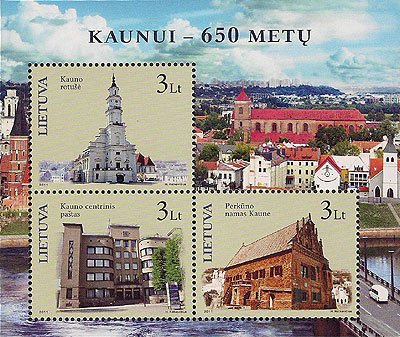
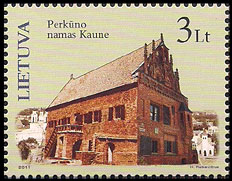
LITHUANIA, 2011, a souvenir sheet for the 650th anniversary of the Kaunas, Scott 937
The House of Perkunas appears on the bottom right stamp,
and the white towers of St. Francis Xavier Church (above) are visible to the
left of the House and also in the selvage to the left of the top stamp
The ancient, Gothic House of Perkunas at 6 Aleksoto Street, in the Old
Town of Kaunas, was originally built by Hanseatic merchants, and served
as their office from 1440 till 1532. The Jesuits bought the building and
established a chapel there in 1643, part of the nearby church and college
complex (see above) until the Suppression in 1773. The house fell into
ruins and was rebuilt in the 19th century and served as a school, and
in 1844 home to the first drama theater of Kaunas. The famous Lithuanian-Polish
poet Adomas Mickevicius (Adam Mickiewicz) worked as a teacher there between
1819 and 1823, and the House, restored to the Jesuits in 1923, contains
a museum in his honor. At the end of the century a figure, thought to
be Perkunas, the Baltic pagan god of thunder and the sky, was found in
one of its walls, and the building was renamed "House of Perkunas." More
The
Church of St. Casimir, Vilnius
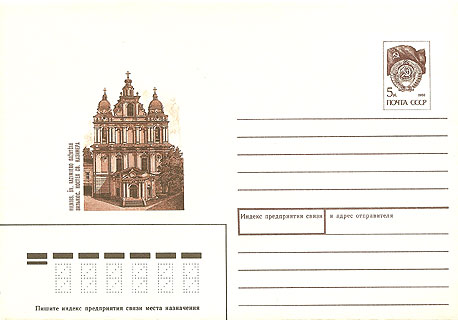
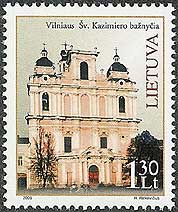
RUSSIA (USSR), 11 July 1990 postal envelope featuring St. Casimir Church
LITHUANIA, 2005, the Jesuit Church of St. Casimir in Vilnius, Scott 797
The Church of Saint Casimir, the first Baroque styled church in Lithuania,
was designed by Italian architect Giano Maria Bernardoni, and constructed
by Lithuanian builder Jonas Prochovicius, and was built in the center
of Vilnius between 1604 and 1618, and consecrated in 1635. But it was
burned down in 1655 and again in 1707 and 1749. The Jesuit architect and
astronomer Tomas Žebrauskas (1714–1758) headed the reconstruction of the church in 1749-55. His
work can be seen in the graded cupola and the main altar. When the Society
of Jesus was suppressed in 1773, the church was given to the Augustinians,
and in time passed to the Orthodox. In 1989, even before communism collapsed,
St. Casimir Church was given back to the Jesuits. They cleaned out the
museum of atheism the Soviets had installed there and went to work.
But there is an old Jesuit school that wraps around the church, and it
was not returned at that time. Built in 1751 as the Collegium Nobilium (School for Nobles), the facilities became military property when the
Society of Jesus was suppressed in 1773. Jesuits reopened the school in
1921, only to have the Communist authorities confiscate it in 1940 for
the Soviet army. In the intervening years, the Soviets used parts of the
building as a school, but it later collapsed through neglect. The new
government has offered the Jesuits a challenge: the property would be
returned if a school were opened by September 1995. Fr. Jonas Boruta,
SJ, provincial of the Jesuits in Lithuania and Latvia, accepted and met
the challenge.
The
University of Vilnius
and the Church of St. John the Baptist and St. John the Evangelist
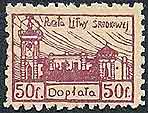
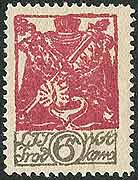
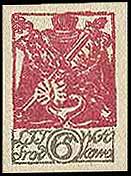
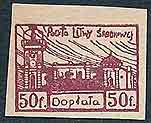
CENTRAL LITHUANIA, 1920-22, university
buildings and the insignia of its rector, Scott J1
and 27 respectively
Central Lithuania was an area around Vilnius seized by the Poles in
1920, absorbed into Poland in 1922, but returned to Lithuania in 1939.
Vilnius had its college and library as early as
1570; it became a university in 1579, and was under Jesuit direction until
the Suppression in 1773. Vilnius University itself survived the Suppression. Because many students took part in the
uprising in Lithuania and Poland in 1830, Tsar Nicholas I, on May 1, 1832
decreed the closure of the university for fear of revolutionary ideas.
On 13 March 1919 Vincas Mickevicius-Kapsukas, one of the organizers and
leaders of the Lithuanian Communist Party, signed a decree of the Soviet
of People's Commissars to reopen the university, and in
1955 the university was renamed in his honor; by 1989 the old name, Vilnius
University, is back.
The
Church of St. John the Baptist and St. John the Apostle began as an ancient Gothic church built in 1387 which
was entrusted to the Jesuits when they opened their college in Vilnius.
The church was rebuilt in 1571 and since then has been considered to be
part of the university
campus. The bell tower of the church was added at the beginning of
the 17th century. It continued to serve the university after the Suppression
of the Jesuits, became a museum of science under the Soviet regime, and
returned to cultic use in 1991. It is again served by two Jesuits who
are university chaplains.
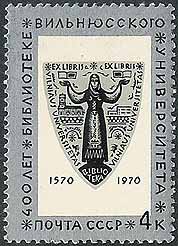

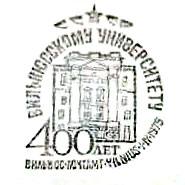
RUSSIA (USSR), 1970, the 4th centenary of the library
of Vilnius University (9 years older than the university), Scott 3772
RUSSIA (USSR), 1979, the 4th centenary of the university and is FDI
cancel, Scott 4731
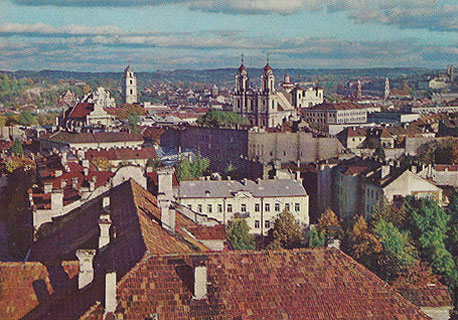
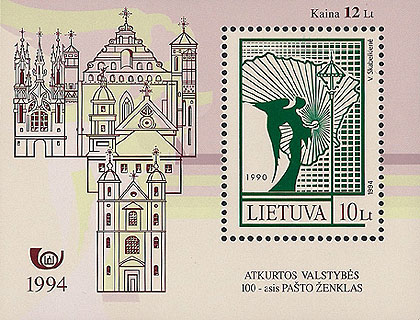
USSR, 8 October 1977, postal card shows the distinctive Church of St. John the Baptist and St. John the Apostle to the left
LITHUANIA, 1994, Scott 492


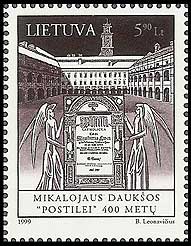
LITHUANIA, 1995, special
cancel for the library's 425th anniversary (9 years older than the university
itself)
LITHUANIA, 1997, Christmas issue, Scott 589
LITHUANIA, 1999, 400th anniversary of the publication of Postilei,
from souvenir sheet, Scott 621
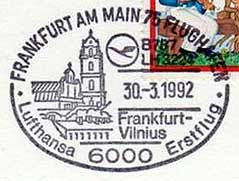
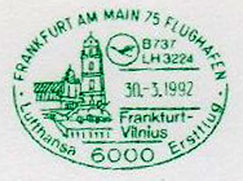
GERMANY, 30 March 1992, special cancels for the first Lufthansa flight
to land in Vilnius featuring the Church of St. John the Baptist and St. John the Apostle and its bell tower.
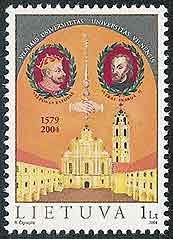
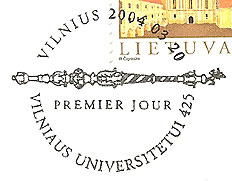
LITHUANIA, 2004, the 425th anniversary,
featuring King Stephen Bathory, the traditional founder
and Father Peter Skarga, SJ, the first rector, Scott
765 and its FDI cancel
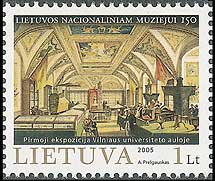
LITHUANIA, 2005, the sesquicentennial of the Lithuanian National Museum,
Scott 792b
this stamp features the first exposition in the aula of Vilnius University.
The room where antique books are kept was the dining room for the Jesuit community
and a painting of Our Lady Queen of the Society can be seen on the ceiling of
the room
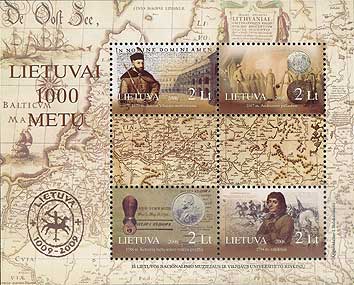
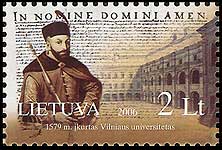
LITHUANIA, 2006, the millennium of Lithuania. The first stamp on the
souvenir sheet honors Vilnius University, founded 1579, Scott 816.
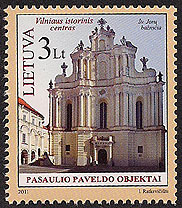
LITHUANIA, 2011, honoring the Vilnius Historic Center, including the Church of St. John the Baptist and St. John the Apostle, inscribed into the UNESCO World Heritage List in 1994, Scott
953
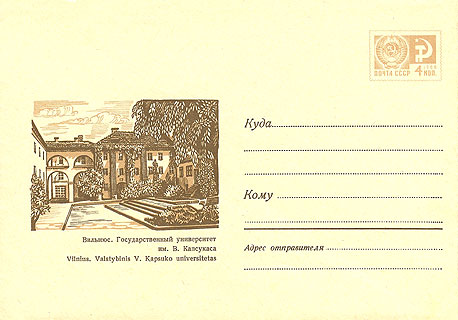
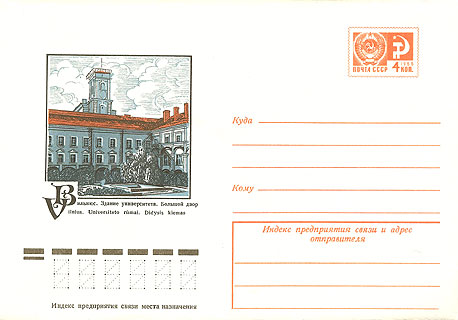
RUSSIA (USSR), 19 September 1969, postal envelope, Kapsukas (Vilnius) University building
RUSSIA (USSR), 12 October 1976, postal envelope, Kapsukas (Vilnius) University building and inner yard
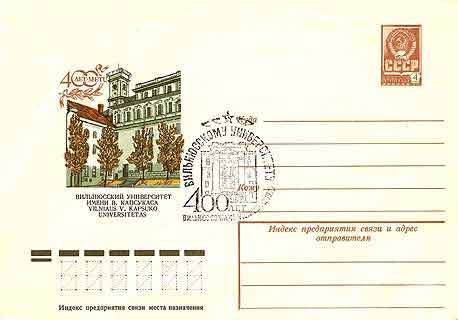
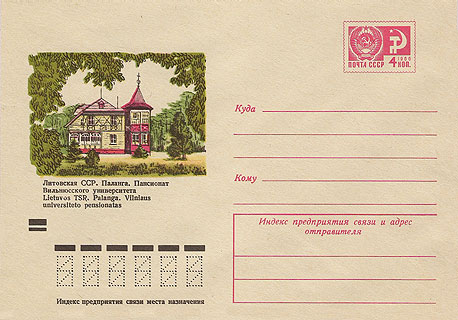
RUSSIA (USSR), 29 November 1978, postal envelope for the 4th centenary
of Kapsukas (Vilnius) University;
the cancel is the FDI cancel for Scott 4731, also for the 4th centenary of the
University
RUSSIA (USSR), 24 April 1973, postal card: Vilnius University rest house
in Palanga Lithuania
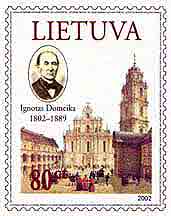
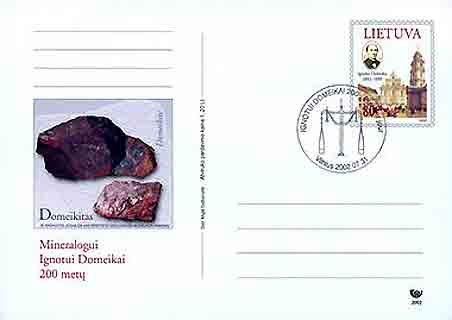

LITHUANIA, 2002, postal card for the bicentenary of birth of Ignacy Domeyko
(1802 - 1889) geologist and mineralogist
the imprinted stamp features Vilnius University and the
Church of St. John the Baptist and St. John the Apostle
POLAND, 1938, postal card showing the church
The
Poczobut Astronomical Observatory, Vilnius
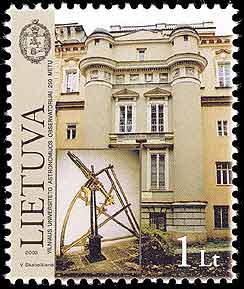
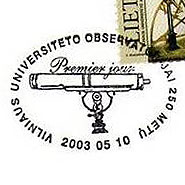
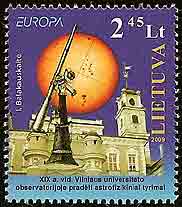
LITHUANIA, 2003, 250th anniversary of the observatory, Scott 745 and
its FDI cancel
LITHUANIA, 2009, Europa Astronomy issue, Scott 893
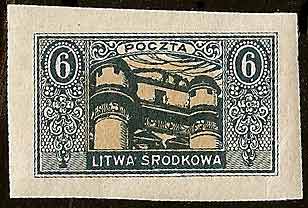

CENTRAL LITHUANIA, 1921, Scott 40

USSR, 1967, postal card featuring the Poczobut
Observatory
Poczobut
Observatory, located on top of the main building of Vilnius University,
was founded in 1753 by the Jesuit astronomer and architect Tomas
Zebrauskas (1714-1758). It was the fourth observatory in Europe and
the oldest in Eastern Europe (and the first observatory to appear on a
stamp). It was named for another Jesuit astronomer, Marcin
Poczobut-Odlanicki (1728-1810), who entered the Society in 1745 until
the Suppression of the Society in 1773. He was mathematics professor,
rector of the University of Vilnius, and became director of the observatory
in 1764 and continued to serve as its director for the next 44 years.
NEXT



















































